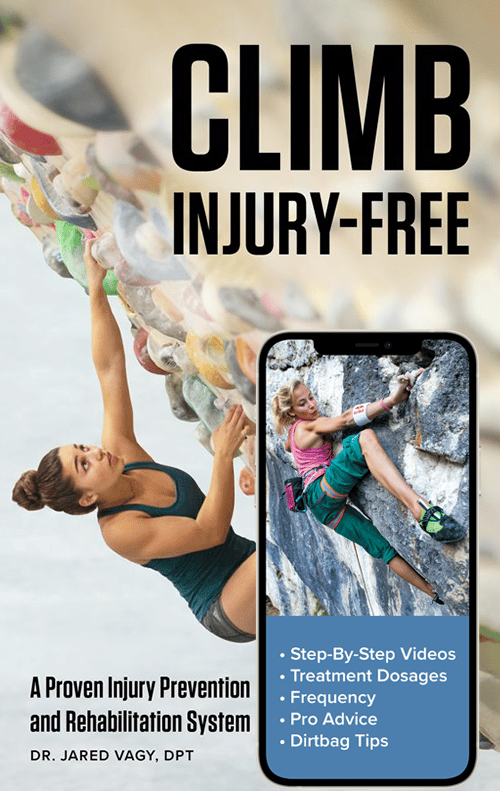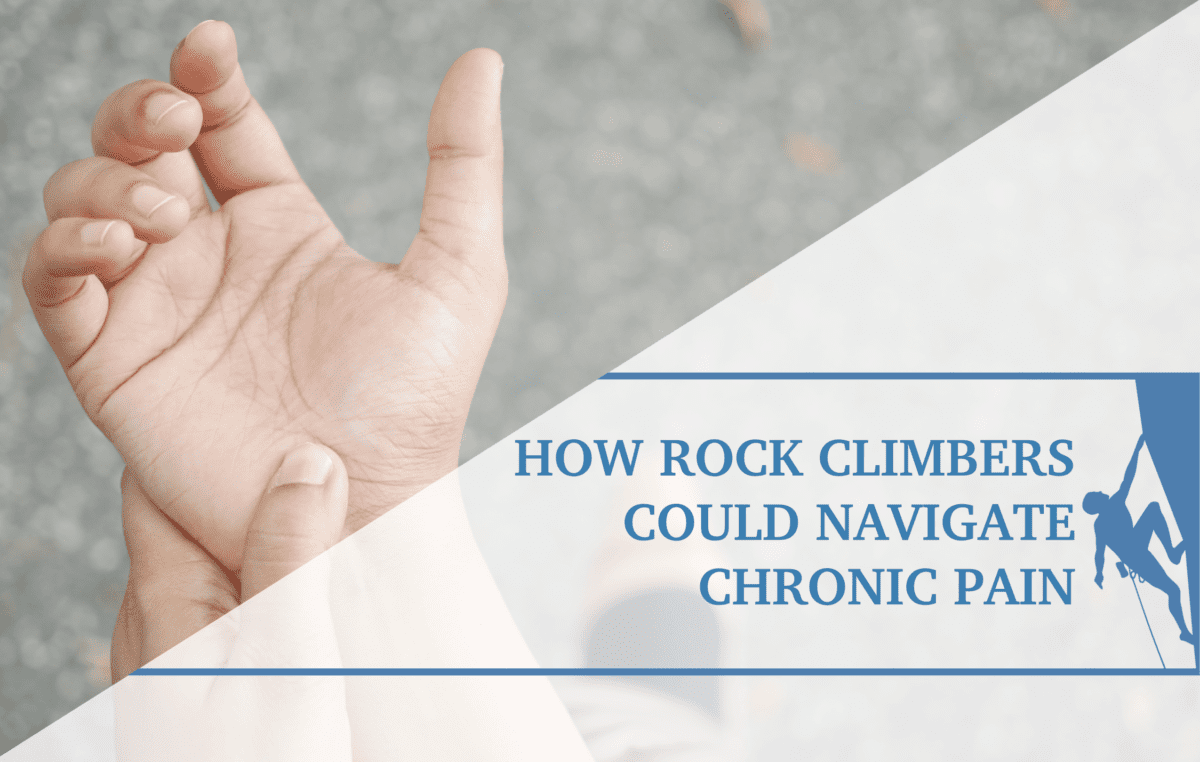What is Hypermobility and How Does It Affect You
Imagine a project where your ability to send is based on matching your toe to a hold on which your hand is already placed. This move is one that I, as a novice climber, have encountered and have been struggling with. However, sometimes you will see people (or you are that person) who can easily reach their leg to the position needed in order to send the project. Sometimes this ability is based on their practiced flexibility but in other situations, the ability to move their limbs into extreme positions might be something that they were born with.
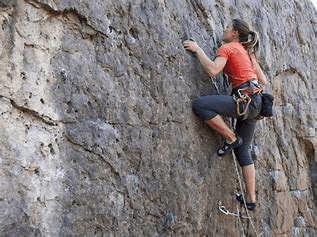
What is hypermobility:
Joint hypermobility is when a person’s synovial joints (for example: your shoulders, elbows, hips, knees, etc.) move further than normal human limits. Joint hypermobility can be due to genetics, years of training, or can develop from certain diseases that affect connective tissues such as Ehlers-Danlos or Marfan Syndrome. Though hypermobility in climbers might seem like an advantage due to the need for flexibility and mobility, there are significant disadvantages that may occur such as pain, muscle or ligament injuries, and joint injuries such as dislocations.1
Diagram of a Synovial Joint: Synovial joints make up most of the major joints in our body. They are filled with synovial fluid, which creates cushioning for the joint and lubricates it for smooth movement. The movement itself is limited by a few things, including the ligaments and muscles around it as well as the shape of the joint itself. There are several types of joint shapes, which determines how the joint will move.
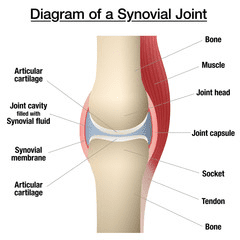
Impact of hypermobility on climbing: Flexibility vs. Hypermobility
When considering why hypermobility is important in climbing, it is first important to understand the difference between joint mobility and flexibility. Flexibility is the ability of a muscle to stretch while joint mobility is the ability of the joint to move actively throughout its range of motion. In other words, flexibility involves muscle length and joint mobility involves joint movement. An example of flexibility is the ability of your hamstrings to allow you to bend over and touch your toes while an example of joint mobility is the ability of your knees or elbows to move into the fully straight (or over extended) position.
Flexibility
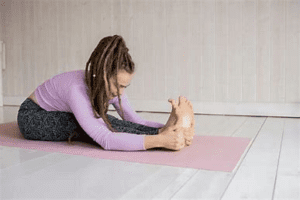
Joint mobility: elbow hyperextension
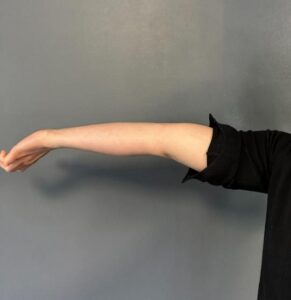
1 Simmonds, J. V., & Keer, R. J. (2007). Hypermobility and the hypermobility syndrome. Manual therapy, 12(4), 298-309.
According to research, flexibility was found to be a significant performance component in climbing-specific tests2. Draper et al. found that the climbers who climbed at higher grades were found to have greater flexibility on average than climbers at lower levels. What this means is if the muscle is longer, indicating greater flexibility, climbers should be able to more easily perform movements that might assist them into certain positions. When joints can move further, climbers are similarly able to move into more extreme positions. However, when joints are pushed into positions past the limits of healthy movement, such as in people with hypermobility, this can lead to eventual pain or even muscle, ligament, or tendon injuries. Flexibility should be improved for better performance both in and outside of the gym. Hypermobility is something that a person is born with but should be addressed in training to prevent injuries from happening.
There are a few theories why joint hypermobility can cause pain or injury. Biomechanically, hypermobile joints are more susceptible to injury due to stress and repetitive use3. Another theory is that loose ligaments and muscle weakness are usually combined, which negatively impacts the joint’s stability. Due to the lack of stability, the joint then will rely on other structures such as the muscle or tendon for stability, which can cause muscular overuse and eventually other injuries such as muscle strain, tension, tendonitis (inflammation), and pain. The last problem that might arise with joint hypermobility is compensation, which is the concept that a joint that is not able to be used functionally will rely on other surrounding structures to achieve function. For example, if you have pain in your shoulder, then you might not want to use your shoulder as much and will then rely on your elbow and hand more, which can eventually cause overuse in the muscles that support your elbow and hand. The body relies on a delicate balance of its muscles for movement: injuries are caused when some muscles are overused when compared with others.
Common Signs and Symptoms
Joint hypermobility affects around 10-15% of the population and largely affects women and children over men. Joint hypermobility also affects more Asians and Africans than Caucasians. Although joint hypermobility occurs in many people, it does not become a problem until it causes symptoms such as pain and instability4. It is important to understand if you have hypermobility so that you can avoid positions that might lead to injury.
People who have joint mobility-causing symptoms often report that starting in childhood, they experienced joint pain in the back and knees, growing pains, or nocturnal leg pain. Other indications of hypermobility are a history of muscle injuries, fractures, and dislocations and subluxations.5 The signs of having an injury due to joint hypermobility are pain that affects the joints for more than 3 months and having a painful joint that dislocates or subluxes frequently.
The most common joint that is injured due to hypermobility is the knee due to its function in walking. The knee also is most often injured in contact sports. In climbing, there has been an increase in overall knee injuries. In Lutter et al., 4 types of moves resulted in traumatic injuries: the high step, drop knee, heel hook, and falls. The article proposes a few mechanisms which might lead to injury but in my opinion, all of these movements could be affected by joint looseness and its consequences, which I highlighted above, such as muscle weakness and compensation.6 Oftentimes, when someone has this kind of injury, it can take extra time for them to rehabilitate or get back to their sport of choice. Anxiety due to worries about their injury or a potential injury due to hypermobility is common as well, especially when a person already has pain in that area. Someone who has pain due to hypermobility or a potential injury must go to their primary care doctor or a physical therapist so that they can heal and recover.
2 Nick Draper, Simon Brent, Chris Hodgson & Gavin Blackwell (2009) Flexibility assessment and the role of flexibility as a determinant of performance in rock climbing, International Journal of Performance Analysis in Sport, 9:1, 67-89, DOI: 10.1080/24748668.2009.11868465
3 Tinkle BT. Symptomatic joint hypermobility. Best Pract Res Clin Rheumatol. 2020 Jun;34(3):101508. doi: 10.1016/j.berh.2020.101508. Epub 2020 Apr 3. PMID: 32249022.
4 Baeza-Velasco, Carolina MA, PhD; Gély-Nargeot, Marie-Christine PhD; Pailhez, Guillem MD, PhD; Vilarrasa, Antonio Bulbena MD, MSc (Cantab). Joint Hypermobility and Sport: A Review of Advantages and Disadvantages. Current Sports Medicine Reports 12(5):p 291-295, September/October 2013. | DOI: 10.1249/JSR.0b013e3182a4b933
5 Simmonds, J. V., & Keer, R. J. (2007). Hypermobility and the hypermobility syndrome. Manual therapy, 12(4), 298-309.
There are a few tests that determine if you have hypermobility. However, the research varies on the exact scores needed to determine if a person actually has joint hypermobility. Your physical therapist or physician may perform the following exams to determine if you have hypermobility (you can perform these tests yourself however if you want a more accurate diagnosis then you should probably make an appointment with a medical professional):
- Beighton scores (4/9 points is positive for hypermobility)7:
- Passively touch the forearm with the thumb, while flexing the wrist (1 point for each thumb)
- More than 10 degrees hyperextension of the elbows (1 point for each elbow)
- Knees hyperextension greater than or equal to 10 (1 point for each knee)
- Passive extension of the fingers or a 90 or more extension of the fifth finger (1 point for each pinky)
- Touching the floor with the palms of the hands when reaching down without bending the knees
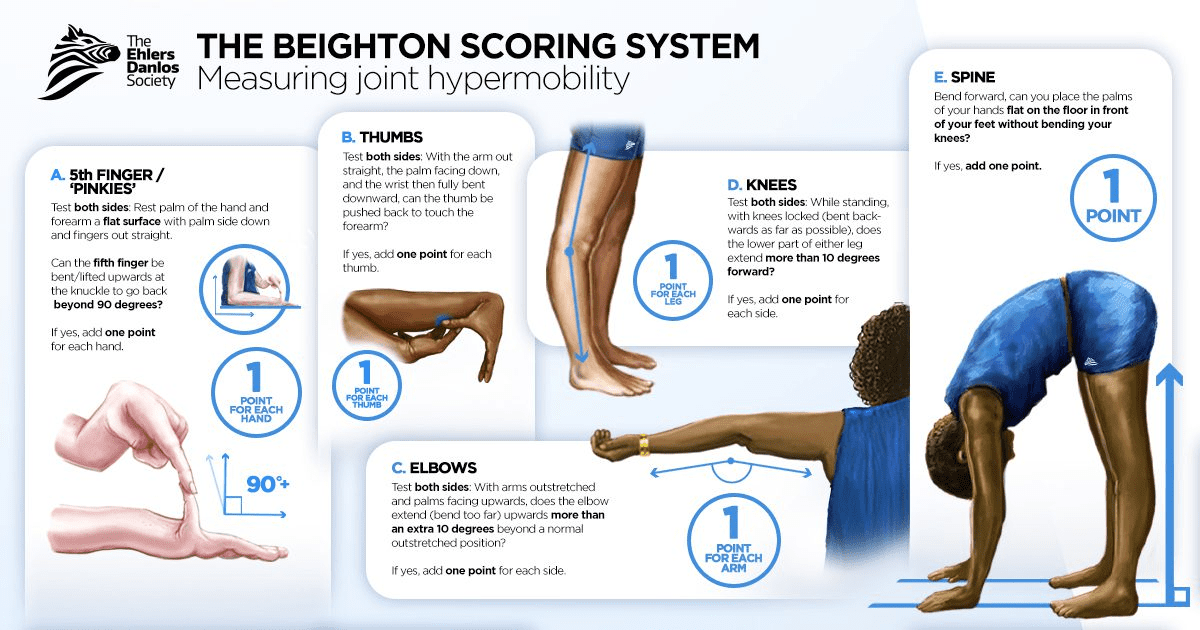
6 Lutter C, Tischer T, Cooper C, Frank L, Hotfiel T, Lenz R, Schöffl V. Mechanisms of Acute Knee Injuries in Bouldering and Rock Climbing Athletes. Am J Sports Med. 2020 Mar;48(3):730-738. doi: 10.1177/0363546519899931. Epub 2020 Jan 31. PMID: 32004071.
7 Malek S, Reinhold EJ, Pearce GS. The Beighton Score as a measure of generalised joint hypermobility. Rheumatol Int. 2021 Oct;41(10):1707-1716. doi: 10.1007/s00296-021-04832-4. Epub 2021 Mar 18. PMID: 33738549; PMCID: PMC8390395.
- Questionnaire:8 a positive diagnosis is the report of yes to 2 or more questions
- Can you now (or could you ever) place your hands flat on the floor without bending your knees?
- Can you now (or could you ever) bend your thumb to touch your forearm?
- As a child, did you amuse your friends by contorting your body into strange shapes or could you do the splits?
- As a child or teenager, did your kneecap or shoulder dislocate on more than one occasion?
- Do you consider yourself “double-jointed”?
Rehabilitation9
Your PT can help you to determine the correct exercises to use to prevent or recover from an injury due to hypermobility. Here are some options in the meantime that might help if you suspect you have joint hypermobility.
- Using joint splints for fingers if you have finger pain. These restrict the motion in your fingers which reduce the changes of overuse or over stretching. You can google “ring splints for hypermobility” or follow the link below.
- Find activities that don’t increase pain.
- Strength training including using weights or bodyweight exercises.
- Note: It is important to be careful to use the correct form and not hyperextend any joints that might be painful (a mirror or taking a video of yourself might be helpful!). Make sure that you aren’t wobbling excessively or losing your balance when doing any of these exercises. If you are, you might want to do some easier versions of the exercises listed below. I have put some general recommendations for the amount of each exercise. The dose of 8-12 reps relies on you doing a hard enough exercise to do it to failure or until your form breaks down. You should try to do these exercises 3 -4 times per week (with a day break in between). If any of these exercises cause pain, please discontinue.
- Legs
- Squats (3 x 8-12 reps): strengthen all lower body muscles including quads, glutes, and hamstrings.
- Easier: squat up and down from a chair
- Harder: pistol squats (single leg squat)
- Bridges (3 x 8-12 reps): strengthen glutes
- Easier: hip thrust on ground
- Harder: single leg bridge
- Lunges (3 x 8-12 reps): strengthen quads
- Easier: lunge while holding onto something
- Harder: weighted lunge
- Proprioceptive exercises (2 x 30-60 seconds): by including balance exercises, you are strengthening all the muscles needed to stabilize your joints more effectively.
- Single leg balance: stand on one leg
- Balance on a bosu ball: stand on one or both legs on the bosu ball
- Bosu ball squats
- Backwards lunges
- Single leg romanian deadlift
- Squats (3 x 8-12 reps): strengthen all lower body muscles including quads, glutes, and hamstrings.
8 Hakim AJ, Grahame R. A simple questionnaire to detect hypermobility: an adjunct to the assessment of patients with diffuse musculoskeletal pain. Int J Clin Pract. 2003 Apr;57(3):163-6. PMID: 12723715.
9 Daman M, Shiravani F, Hemmati L, Taghizadeh S. The effect of combined exercise therapy on knee proprioception, pain intensity and quality of life in patients with hypermobility syndrome: A randomized clinical trial. J Bodyw Mov Ther. 2019 Jan;23(1):202-205. doi: 10.1016/j.jbmt.2017.12.012. Epub 2017 Dec 15. PMID: 30691753.
-
- Arms:
-
-
- Shoulder strengthening: a lot of shoulder pain can be caused by weak external rotators (the muscles that stabilize your shoulder as you raise it) so by strengthening these, you can stabilize your shoulder better
- Rows (3 x 8-12 reps)
- Banded No moneys (3 x 8-12 reps)
- Proprioceptive exercises (2 x 30- 60 seconds): similarly to balance exercises using your legs, you are building up the stabilization muscles of your arms, your joints including your shoulders, elbows, and wrists will be more secure
- Bird dogs
- High planks (with shoulder taps)
- Planks on a bosu ball or unsteady surface
- Plank push ups on a bosu ball
- Upper extremity walking with resistance bands
- Shoulder strengthening: a lot of shoulder pain can be caused by weak external rotators (the muscles that stabilize your shoulder as you raise it) so by strengthening these, you can stabilize your shoulder better
-
- If you do have hypermobility, you should consider limiting things like stretching or moving your joints into weird positions, even if it is not painful, because that can cause damage that can make itself known in the future.
See a Doctor of PT
If you suspect you have an injury or have a lot of pain, you should make an appointment with a physician or a physical therapist. Physical therapists are experts in movement and can diagnose and treat musculoskeletal injuries.
Author Bio
Savannah Seifferth is studying to get her doctorate in physical therapy at Arcadia University in Philadelphia, Pennsylvania. Originally from Franklin, Tennessee, she pursued her undergraduate studies at the University of Alabama, receiving a bachelor of science in biology, summa cum laude. In her free time, Savannah enjoys all types of physical fitness including lifting weights, yoga, hiking, playing soccer, and more recently, bouldering. Savannah hopes to gain more experience in helping people with the rehabilitation of their sport-related injuries.
Resources
- Simmonds, J. V., & Keer, R. J. (2007). Hypermobility and the hypermobility syndrome. Manual therapy, 12(4), 298-309.
- Nick Draper, Simon Brent, Chris Hodgson & Gavin Blackwell (2009) Flexibility assessment and the role of flexibility as a determinant of performance in rock climbing, International Journal of Performance Analysis in Sport, 9:1, 67-89, DOI: 10.1080/24748668.2009.11868465
- Tinkle BT. Symptomatic joint hypermobility. Best Pract Res Clin Rheumatol. 2020 Jun;34(3):101508. doi: 10.1016/j.berh.2020.101508. Epub 2020 Apr 3. PMID: 32249022.
- Baeza-Velasco, Carolina MA, PhD; Gély-Nargeot, Marie-Christine PhD; Pailhez, Guillem MD, PhD; Vilarrasa, Antonio Bulbena MD, MSc (Cantab). Joint Hypermobility and Sport: A Review of Advantages and Disadvantages. Current Sports Medicine Reports 12(5):p 291-295, September/October 2013. | DOI: 10.1249/JSR.0b013e3182a4b933
- Lutter C, Tischer T, Cooper C, Frank L, Hotfiel T, Lenz R, Schöffl V. Mechanisms of Acute Knee Injuries in Bouldering and Rock Climbing Athletes. Am J Sports Med. 2020 Mar;48(3):730-738. doi: 10.1177/0363546519899931. Epub 2020 Jan 31. PMID: 32004071.
- Malek S, Reinhold EJ, Pearce GS. The Beighton Score as a measure of generalised joint hypermobility. Rheumatol Int. 2021 Oct;41(10):1707-1716. doi: 10.1007/s00296-021-04832-4. Epub 2021 Mar 18. PMID: 33738549; PMCID: PMC8390395.
- Hakim AJ, Grahame R. A simple questionnaire to detect hypermobility: an adjunct to the assessment of patients with diffuse musculoskeletal pain. Int J Clin Pract. 2003 Apr;57(3):163-6. PMID: 12723715.
- Daman M, Shiravani F, Hemmati L, Taghizadeh S. The effect of combined exercise therapy on knee proprioception, pain intensity and quality of life in patients with hypermobility syndrome: A randomized clinical trial. J Bodyw Mov Ther. 2019 Jan;23(1):202-205. doi: 10.1016/j.jbmt.2017.12.012. Epub 2017 Dec 15. PMID: 30691753.
- Disclaimer – The content here is designed for information & education purposes only and the content is not intended for medical advice.

